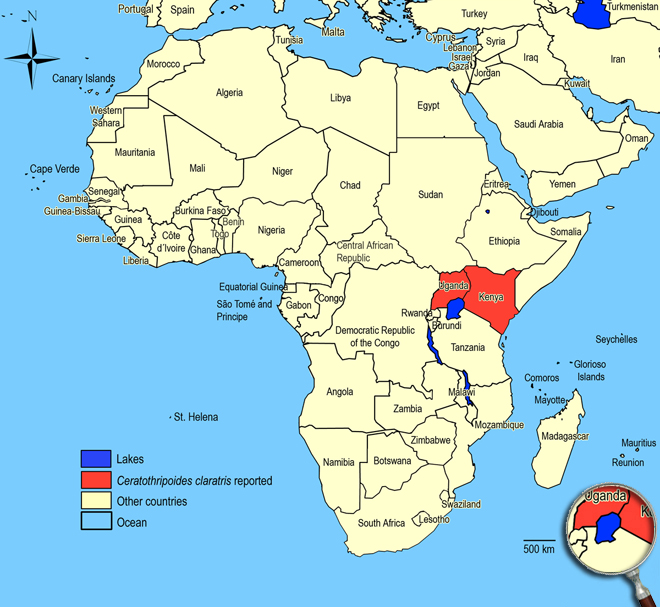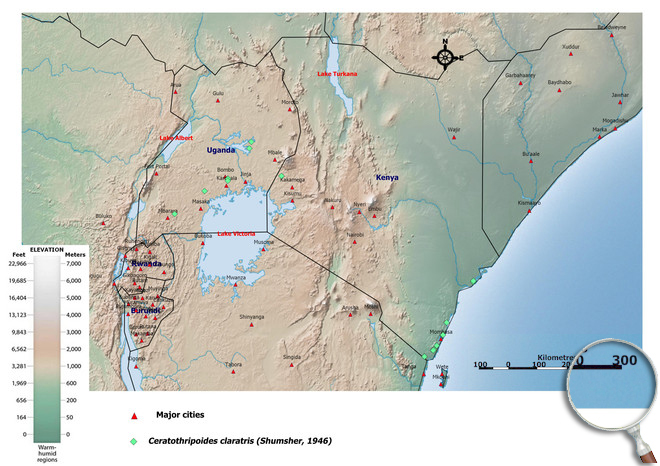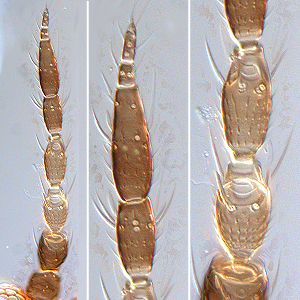Ceratothripoides claratris (Shumsher, 1946)
Thripinae, Thripidae, Terebrantia, Thysanoptera
Figures
Fig. 1: 8-segmented antenna, terminal segments V-VIII, segments III and IV with forked sense cone
Fig. 2: Head dorsal with ocellar triangle
Fig. 3: Head ventral with mouthcone, left mandible and fore tentorial arms
Fig. 4: Pronotum
Fig. 5: Meso- and metanotum
Fig. 6: Meso- and metasternum with endosceletal furca
Fig. 7: Fore wing and distal region of fore wing
Fig. 8: Sternites VI and VII
Fig. 9: Tergites V and VI
Fig. 10: Tergite VIII with posteromarginal comb and tergite IX
Fig. 11: Tergites IX and X
Introduction and recognition
Ceratothripoides claratris is a tospovirus vector capable of transmitting Capsicum chlorosis virus. It causes considerable damage to tomato plants and fruits. Both sexes fully winged. Body brown; legs yellow with extensive brown shadings particularly on hind femora; antennal segment III yellow, IV variably yellow and brown, V brown; fore wings pale but weakly shaded. Antennae 8-segmented; segments III & IV with forked sense cone and many microtrichia, segment I with pair of dorso-apical setae (Fig. 1). Head with 3 pairs of ocellar setae, pair III almost twice as long as lateral margin of ocellar triangle and arising on anterior margin of ocellar triangle; compound eyes with 4 or 5 weakly pigmented facets (Fig. 2). Pronotum with 2 pairs of elongate posteroangular setae (Fig. 3). Mesonotum without campaniform sensilla; mesosternal furca with spinula. Metanotum sculptured lines always transverse at anterior, but with irregular equiangular reticulation near posterior; median setae at anterior margin more than two-thirds as long as metanotum; campaniform sensilla absent (Fig. 4 and 5). Mid and hind tarsi 2-segmented. Fore wing first vein with about 7 setae basally and 2 setae distally; second vein with complete setal row; clavus with 5-6 marginal setae but no discal setae (Fig. 6). Tergites without ctenidia; tergite VIII posterior margin with complete comb of long and slender microtrichia (Fig. 8 and 9); X with dorsal split (Fig. 11). Sternites III-VI with 3 pairs of marginal setae, marginal setae as long as sternites; sternite VII setae S1 and S2 arising well in front of posterior margin (Fig. 7).
Male smaller than female; sternites III-VII each with about 12 small glandular areas in two irregular transverse rows; tergite IX without stout thorn-like setae.
Taxonomic identity
Species
Ceratothripoides claratris (Shumsher, 1946)
Taxonomic history
Ceratothrips reticulatus Reyes, 1994
Mycterothrips moultoni Seshadri & Ananthakrishnan, 1954
Taeniothrips claratris Shumsher, 1946
Common name
Oriental tomato thrips
Present taxonomic position
Family: Thripidae Stephens, 1829
Subfamily: Thripinae (Stephens) Karny, 1921
Genus: Ceratothripoides Bagnall, 1918
Genus description
The genus Ceratothripoides Bagnall, 1918
This genus comprises 5 Old World species from the Africa and the Oriental region. One of these species, Ceratothripoides claratris, is recorded as a tospovirus vector on tomatoes with different levels of virulence (Premachandra et al. 2005; Halaweh & Poehling 2009). Species of Ceratothripoides have following characters: 8-segmented antennae, antennal segments III & IV with forked sense cone, antennal segment I with a pair of small dorso-apical setae, tergite VIII posterior margin with complete comb of long microtrichia, sternites III-VI with 3 pairs of marginal setae, and sternite VII with S1 and S2 arising well in front of posterior margin (Mound & Nickle 2009). All of them have a wide gap in the setal row on the first vein of fore wing, and a complete setal row on the second vein. In some cases, like Ceratothripoides claratris and Ceratothripoides cameroni discrimination is difficult and not always clear.
Species description
Typical key character states of Ceratothripoides claratris
Coloration and body sculpture
Body color: mainly brown to dark brown
Surface of head, pronotum and fore legs: without obvious or with weakly reticulate sculpture
Antennae
Form of sense cones on antennal segments III and IV: emergent and forked on segments III and IV
Number of antennal segments: 8
Antennal segment I: with pair of small setae on dorso-apical margin
Antennal segment II: without an exceptionally long seta at the inner apex
Antennal segment II shape: symmetric
Antennal segment III shape: symmetric
Antennal segment IV and V: without a hyaline ring at the base
Antennal segment VI bears: not a remarkably dagger-shaped sensorium
Forked sense cone on antennal segment IV: scarcely extending beyond base of segment V
Length of antennal segment III and IV: antennal segment III similar in length to segment IV
Head
Distance between bases of ocellar setae III: greater than width of first ocellus
Head: not prolonged in front of compound eyes
Ocellar setae I: present (mostly one behind the other)
Length of ocellar setae II: shorter than setae III
Ocellar setae III: arising on anterior margin of, or in front of ocellar triangle
Ocelli: present
Length of postocular setae: not alternating short and long setae
Number of ocellar setae: 3
Compound eyes: with 4 or more weakly pigmented facets
Prothorax
Number of pairs of long anteroangular setae: 0
Number of pairs of long posteroangular setae: 2
Number of pairs of elongate pronotal setae: 2
Number of pairs of posteromarginal minor setae: 3-4
Pronotal blotch or internal apodeme: absent
Pronotum shape: broadly rectangular
Pronotum posteromarginal/posteroangular setae: S2 longer than S3, not equal in length
Mesothorax
Campaniform sensilla: absent
Mesosternal furca: with median spinula
Metathorax
Metanotal campaniform sensilla: absent
Metanotal median setae: S1 at anterior margin
Metanotum with dominant sculptured triangle medially: absent
Metasternal furca: without spinula
Sculpture of metanotum median area: transverse at anterior, but irregular longitudinal or equiangular reticulations on posterior half
Shape of metathoracic furca: transverse, V-shaped
Metanotal median setae length: longer than lateral metanotal setae
Wings
Fore and hind wings: present, more than half as long as abdomen (macropterous)
Fringe cilia arising: from sockets
Fore wing veins: present
Fore- and hind wing surface: covered with microtrichia
Apex of fore wing: with prominent terminal setae
Fore wing anterior margin (costal vein): with setae and cilia but cilia longer than setae
Fore wing clavus - number of discal setae: 0
Fore wing clavus - number of marginal setae: 5-6
Fore wing costal fringe cilia: arising at anterior margin of wing
Fore wing first vein: distinct from costal vein
Fore wing first vein setal row: incomplete, with setae not closely and uniformly spaced
Fore wing second vein setal row: complete, setae uniformly spaced
Fore wing shape: mainly parallel sided or margins run continuously towards each other
Fore wing surface: not reticulate
Fore wing first vein number of setae on distal half: 2
Fringe cilia on posterior margin near apex: distinctly wavy (undulated)
Shape of fore wing apex: with mainly posterior margin curved to join anterior margin
Fore wing extreme apex color: pale
Fore wings: uniformly pale or weakly shaded
Legs
Fore tibia: not prolonged around fore tarsus
Mid and hind tarsi: with two segments
Color of fore tarsi: pale or yellow, sometimes apical shaded or brown
Abdomen
Pleurotergites: not covered in microtrichia
Sternite II: with marginal setae but no discal setae
Sternites IV, V and VI: with marginal setae but no discal setae
Sternite VII median posteromarginal setae S1: arising in front of posterior margin
Sternite VII: with marginal setae but no discal setae
Craspedum on tergites IV to VI: absent
Surface of lateral thirds of abdominal tergites: without regular rows of fine microtrichia
Tergites II to VII median setal pair: no more than 0.3 as long as median length of tergite
Tergites IV and V median setal pair: shorter than distance between their bases
Tergites V to VII: without ctenidia laterally, but sometimes with rows of microtrichia
Tergite VIII ctenidia: without paired ctenidia laterally, sometimes with irregular microtrichia
Tergite VIII posteromarginal comb of microtrichia: present and complete medially
Tergite VIII shape of posteromarginal microtrichia: long, slender and irregular or regular
Tergite X: not tubular, longitudinally incomplete
Setae on abdominal tergite X: all setae slender

Similar or related species
Ceratothripoides claratris is very similar to Ceratothripoides cameroni and differ only by color: Bhatti (1990) indicated that Ceratothripoides claratris has antennal segment V and legs extensively brown, whereas Ceratothripoides cameroni has antennal segment V yellow or shaded and legs yellow. But several specimens have remarkable variable coloration. Whether these slight differences in color represent two distinct species, or whether they are symptoms of intraspecific variation, as suggested by zur Strassen (1975), remains unclear. The palest specimens, those that would be associated with the name Ceratothripoides cameroni, appear to come from the more arid areas, whereas the darker specimens, that would be associated with the name Ceratothripoides claratris, come generally from more humid areas (Mound & Nickle 2009). Another difference becomes apparent in metanotal median area sculptured lines. Median area of Ceratothripoides cameroni shows mainly equiangular reticulation, whereas in Ceratothripoides claratris sculptured lines are transverse at anterior, but with irregular equiangular reticulations near posterior. Compared to other species, both have uniformly pale fore wings with no dark shadings and compound eyes with 4 or 5 weakly pigmented facets (Ceratothripoides brunneus and Ceratothripoides revelatus with brown or deeply shaded fore wings and compound eyes without pigmented facets). Furthermore, in Ceratothripoides cameroni and Ceratothripoides claratris ocellar setae III arising always on anterior margin of ocellar triangle and the distance between bases of ocellar setae III is always greater than width of first ocellus (in Ceratothripoides revelatus always less than width of first ocellus; in Ceratothripoides brunneus less, same or greater than width of first ocellus; both with ocellar setae III arising within ocellar trianlge). Ceratothripoides revelatus differs from other three species in having the meso- and metanotum with campaniform sensilla, and the fore wing clavus with 5 or 6 marginal setae and 1 discal seta, whereas other species have a meso- and metanotum without campaniform sensilla, and the fore wing clavus with 6 or 7 marginal setae but no discal seta (Ceratothripoides brunneus) or with 5 or 6 marginal setae and no discal seta (Ceratothripoides cameroni and Ceratothripoides claratris).
Species of Ceratothripoides are similar to species of Craspedothrips, Diarthrothrips coffeae, Lefroyothrips pictus, Megalurothrips sjostedti and Tenothrips frici in having 8-segmented antennae with forked sense cone on segments III and IV and 2 pairs of elongate pronotal setae posteroangularly, in lacking ctenidia laterally on tergites V-VIII and regular rows of fine microtrichia on lateral thirds of tergites. Species of Ceratothripoides as well as Lefroyothrips pictus differ from other species by the complete posteromarginal comb of slender microtrichia on tergite VIII, whereas other species have a continuous craspedum (Craspedothrips hargreavesi), no comb of microtrichia (Craspedothrips xanthocerus, Diarthrothrips coffeae) or a comb of short microtrichia only laterally on posterior margin of tergite VIII (Megalurothrips sjostedti and Tenothrips frici). Compared to Lefroyothrips pictus with distinctly bicolored body color, antennal segment I without any setae on dorso-apical margin, metanotal median area scarcely sculptured on posterior half, and median pair of marginal setae on sternite VII arising at margin, species of Ceratothripoides with usually uniformly brown body color, antennal segment I with a pair of small setae on dorso-apical margin, metanotal median area always sculptured with equiangular reticulations on posterior half, and median posteromarginal setae on sternite VII arise always in front of margin. Furthermore, species of Ceratothripoides have the fore wings usually uniformly brown or uniformly pale or yellow, compared to Lefroyothrips pictus with banded fore wings.
Biology
Life history
As with other thrips species the life cycle from egg to adult is dependent on temperature. The full cycle can take less than a week to over a month and adults may live for more than one month producing several generations in one year depending on seasonal weather (Lewis 1973).
Host plants
Solanaceous and other crops.
Crops: African spiderplant (African cabbage), capsicum, cowpea, eggplant, maize, onion, tomato.
Weeds: Amaranthus sp., Cassia angustifolia, Mimosa sp., Solanum incanum, Vernonia popeana.
Vector capacity
Capsicum chlorosis virus (Premachandra et al. 2005)
Damage and symptoms
Damage symptoms include silvering of the abaxial leaf surface and the leaves crinkle. Malformed fruits with brown rusty lesions are also observed on the fruits.
Detection and control strategies
This species is commonly observed in the humid regions along the coast of Lake Victoria or the Indian Ocean. Ceratothripoides claratris is parasitized by Goetheana shakespearei and it was better than Ceranisus menes (Murai et al. 2000).
Additional notes
Breeding in flowers, on young fruits, and on leaves.
Biogeography
Oriental region, from India to Thailand, Philippines.
African countries where Ceratothripoides claratris has been reported

Occurence of Ceratothripoides claratris in East Africa

Please click here for survey sites of all observed thrips species of Kenya, Tanzania and Uganda.
Click here for locations of Ceratothripoides claratris in parts of East Africa.

Bibliography
Bhatti JS (1990). Catalogue of insects of the Order Terebrantia from the Indian Subregion. Zoology (Journal of Pure and Applied Zoology). 2 (4): 205-352
Bhatti JS (2003). The genera Tenothrips and Ewartithrips (Terebrantia: Thripidae) and pigmented facets of eye in some Terebrantia. Thysanoptera. 2003: 1-10
Halaweh N & Poehling H-M (2009). Inheritance of vector competence by the thrips Ceratothripoides claratris (Shumsher) (Thysanoptera: Thripidae). Journal of Applied Entomology 133: 386-393
Lewis T (1973). Thrips: their biology, ecology and economic importance. Academic Press Inc., London Ltd., 349 pp
Moritz G (2006). Thripse. Pflanzensaftsaugende Insekten, Bd. 1, (1. Auflage). Westarp, Hohenwarsleben, 384 pp. ISBN-13: 978 3 89432 891 7
Mound LA & Nickle DA (2009). The Old-World genus Ceratothripoides (Thysanoptera: Thripidae) with a new genus for related New-World species. Zootaxa. 2230: 57-63
Murai T, Kawai S, Chongratanameteekul W & Nakasuji F (2000). Damage to tomato by Ceratothripoides claratris (Shumsher) (Thysanoptera: Thripidae) in central Thailand and a note on its parasitoid, Goetheana shakespearei Girault (Hymenoptera: Eulophidae). Applied Entomology and Zoology. 35 (4): 505-507
Premachandra DWTS, Borgemeister C, Chabi-Olaye A & Poehling H-M (2004). Influence of temperature on the development, reproduction and longevity of Ceratothripoides claratris (Thysanoptera: Thripidae) on tomatoes in Thailand. Bulletin of Entomological Research. 94: 377-384
Premachandra DWTS, Borgemeister C, Maiss E, Knierim D & Poehling H-M (2005). Ceratothripoides claratris, a new vector of a capsicum chlorosis virus isolate infecting tomato in Thailand. Phytopathology. 95 (6): 659-663
Premachandra DWTS, Borgemeister C, Sétamou M, Achilles T & Poehling H-M (2005). Spatio-temporal distribution of Ceratothripoides claratris (Thysanoptera: Thripidae) on tomatoes in Thailand. Environmental Entomology. 34 (4): 883-890
Reyes CP (1994). Thysanoptera (Hexapoda) of the Philippine Islands. The Raffles Bulletin of Zoology. 42 (2): 107-507
Seshadri A & Ananthakrishnan TN (1954). Some new Indian Thysanoptera - 1. Indian Journal of Entomology. 16: 210-226
Shumsher S (1946). Studies on the systematics of Indian Terebrantia. Indian Journal of Entomology. 7: 147-188
zur Strassen R (1975). Thysanopterologische Notizen (3) (Insecta: Thysanoptera). Senckenbergiana Biologica. 56 (1-3): 75-88
----
Web links
Mound´s Thysanoptera pages
Thysanoptera Checklist
ICIPE Thrips survey sites
UNI Halle & Thrips sites
Thrips of California















